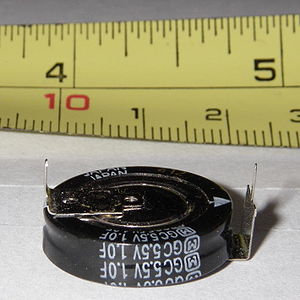Farad
| Farad | |
|---|---|

A 1 farad capacitor
|
|
| Unit system | SI derived unit |
| Unit of | Capacitance |
| Symbol | F |
| Named after | Michael Faraday |
| In SI base units: | s4⋅A2⋅m−2⋅kg−1 |
The farad (symbol: F) is the SI derived unit of electrical capacitance, the ability of a body to store an electrical charge. It is named after the English physicist Michael Faraday.
One farad is defined as the capacitance across which, when charged with one coulomb, there is a potential difference of one volt. Equally, one farad can be described as the capacitance which stores a one-coulomb charge across a potential difference of one volt.
The relationship between capacitance, charge and potential difference is linear. For example, if the potential difference across a capacitor is halved, the quantity of charge stored by that capacitor will also be halved.
For most applications, the farad is an impractically large unit of capacitance. Most electrical and electronic applications are covered by the following SI prefixes:
A farad has the base SI representation of: s4 × A2 × m−2 × kg−1
It can further be expressed as:
where F=farad, A=ampere, V=volt, C=coulomb, J=joule, m=metre, N=newton, s=second, W=watt, kg=kilogram, Ω=ohm, H=henry.
The term "farad" was originally coined by Latimer Clark and Charles Bright in 1861, in honor of Michael Faraday, for a unit of quantity of charge but by 1873, the farad had become a unit of capacitance. In 1881 at the International Congress of Electricians in Paris, the name farad was officially used for the unit of electrical capacitance.
...
Wikipedia
